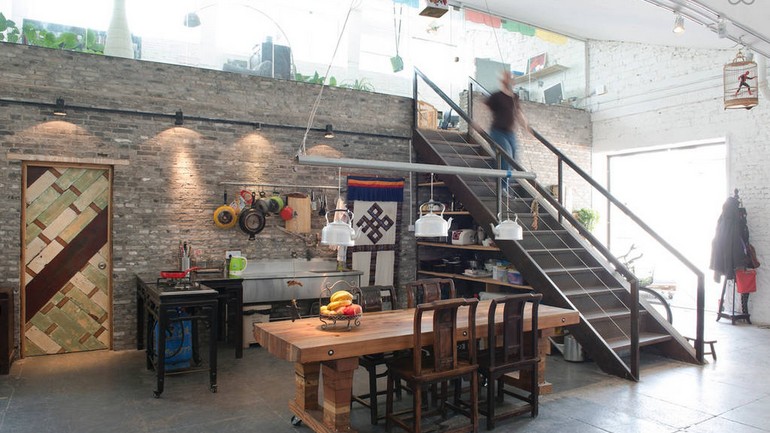
A desire to escape corporate drudgery as well as their tiny one-bedroom apartment prompted Jonas Merian and Nina Chen to search for a warehouse that they could call their own.
抱着逃离辛苦而单调的打工生活,也逃离他们那间狭小的单卧室公寓的愿望,乔纳斯·梅里安和尼娜·陈努力寻找着一处可以属于他们自己的仓库。
“We were both kind of tired of working for a company, so we quit our jobs at the same time, more or less,” Mr. Merian, 38, said. “I wanted to become more creative again — that’s why I wanted to have a workshop where I could build something. She just wanted to become a freelance photographer instead of working for a boss.”
“我们都有点厌倦在公司工作了,所以我们同时辞去了职务,差不多同时吧,”38岁的梅里安说,“我想重新变得有创造力一些——这就是为什么我想拥有一间工作室,让我能在里面造点什么东西出来。而她就想成为一名自由摄影师,而不是为某个老板工作。”
Ms. Chen grew up in Hubei Province, in central China, and moved to Shanghai as an adult. The couple met five and a half years ago when Mr. Merian, a Swiss citizen, came to Shanghai after spending two years in Beijing.
陈女士在中国中部的湖北省长大,成年后迁居上海。这对夫妇于五年半之前相识。当时,身为瑞士公民的梅里安在北京待了两年后,来到了上海。
Now they, along with their 20-month-old daughter, Anna, rent a warehouse in the Wu Wei Creative Park, a government-owned space in the northern district of Yangpu.
现在,他们带着刚20个月大的女儿安娜,在杨浦区北部一处隶属于政府的五维创意园中,租下一间仓库。
Parks such as Wu Wei, collections of unused warehouses and former industrial centers, are common in China’s big cities. Creative enterprises generally use them for office space, but in recent years some in the country’s artistic community have complained that the enclaves are becoming too commercial.
类似五维这样集中了许多空置仓库,且曾是工业中心的创意园,在中国的大城市中非常普遍。创意型企业一般把这里用作办公地点。但近些年来,国内艺术社区中的一些企业开始抱怨,这些独树一帜的创意园已经变得太商业化了。
Wu Wei is no exception. An art museum and several artists’ studios are on site, but the path between the street and Mr. Merian and Ms. Chen’s home is often dotted with young couples posing for pictures outside the park’s many wedding photography studios.
五维也不例外 。这里有一座艺术博物馆和几间艺术家工作室,但是在梅里安和陈女士的家与大街之间的一条小路上,经常站着一些在该创意园中的许多婚礼照相馆外摆姿势拍照的年轻夫妇。
Ms. Chen, 34, considers the businesses, which now occupy about 80 percent of the park’s space, to be a threat to the less-commercial creative people living and working here.
34岁的陈女士认为,这些已经占据创意园80%空间的行业,对一些在这里工作与生活的、不那么商业化的创意人来说,是个威胁。
“I think long-term, they will kick us out,” she said. “Those wedding studios earn a lot of money. They can pay the rent, even if the price is increased quite high.”
“我怕时间一长,他们就会把我们挤出来了,”她说,“那些婚礼工作室很赚钱。即使价格涨得非常高,他们也付得起租金。”
It was a different story four years ago, when the couple first saw the Creative Park.
四年前,则是另一种情况。当时这对夫妻还是第一次见到这座创意园。
“When we came here, it was just beginning and we got a good price for one big empty hall and we could basically do whatever we wanted,” Mr. Merian said. “There was nothing fixed and it was very exciting to basically be able to decide: Should we make a wall here, or there? How should we arrange it?”
“我们来到这里时,创意园才刚刚起步,所以我们签了个好价钱,租下一大间空旷的大厅,然后我们基本上可以做任何我们想做的事,”梅里安说,“没有什么是固定不变的。基本上我们就可以决定:是在这里建一堵墙呢,还是在那里建?我们该怎样设计它?这种感觉非常令人兴奋。”
The couple set to work on renovations, but before long they realized that they needed help and called in contractors.
夫妻俩开始着手改造新家,但没过多久,他们意识到自己需要帮助,于是找来了施工承包商。
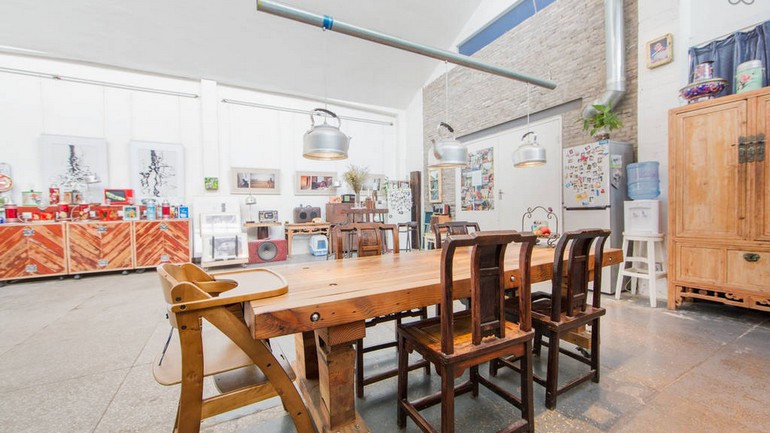
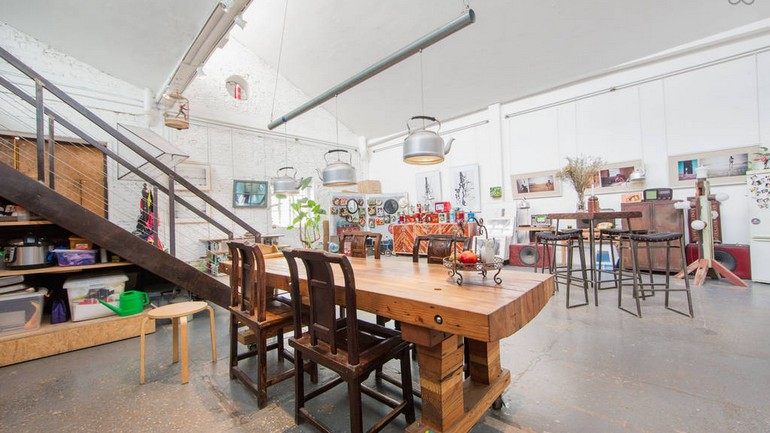
Over a six-week period, plaster was removed from the interior walls to reveal the original brickwork and a staircase and mezzanine level were added to serve as a living room and home office. Also, the entire interior and the warehouse’s concrete facade were repainted.
在六周时间里,他们刮掉了室内墙面的灰泥,露出原始墙砖,还增加了一段楼梯与一处用作客厅和家庭办公室的中间层。另外,他们还把整个仓库的室内墙面与水泥外立面重刷了一遍。
In the end, they had a 3,230-square-foot space with three bedrooms and one bathroom.
最后,他们得到了一处面积3230平方英尺的空间,带有三间卧室和一间浴室。
“To save money,” Mr. Merian said, “we used secondhand bricks and the wooden floor is from a demolished house.”
“为了省钱,”梅里安说,“我们用了来自一栋拆迁房的二手砖块和木地板。”
Though these changes were enough to make the place livable, Anna’s imminent arrival two years ago prompted some additional renovations to make the place a safer and more comfortable family home. They included enclosing the mezzanine with bricks and glass, adding a handrail to the staircase and installing air-conditioning and heating.
虽然这些变化已经足以令此地适宜居住,但两年前因安娜即将出世,还是追加了一些装修,以便让这里成为一座更安全、更舒适的家庭住宅。其中包括用砖块和玻璃把中间层做成全封闭空间,增加了楼梯扶手,并安装了空调和暖气。
Mr. Merian estimates that they have invested 100,000 renminbi, or about $16,000, in renovations. But for the near future, he said, “my plan is to not have any more renovations — I am tired of renovations by now.”
梅里安估计,他们在改造工程中已投入了10万元人民币,或大约16000美元。但在可预见的将来,他说,“我的计划是不再做任何改动——我现在对房屋改造已经厌倦了。”
When the initial three-year lease expired last summer, Mr. Merian and Ms. Chen signed on for an additional two years, at 7,500 renminbi a month.
去年夏天,头三年的租约到期,梅里安与陈女士又续签了两年,租金是每月7500元人民币。
Theirs is an unusual living situation in Shanghai, where the vast majority of the city’s more than 20 million residents live in high-rise apartments in the city center and a significant minority in colonial-era lane houses and low-rise apartments.
在上海,他们的居住情况是一种不同寻常的生存状态,因为在这座城市超过2000万人口的居民当中,绝大多数都生活在位于市中心的高层公寓中,还有极少数生活在殖民时代的里弄房屋与低层公寓里。
Adjusting to life outside the center was easy, according to Ms. Chen, who says she enjoys their location. The warehouse is a five-minute walk from Gongqing Forest Park — 324 acres of green space, fir trees and lakes, where the family often takes walks on quiet weekday mornings.
据陈女士说,适应中心区之外的生活非常容易。她说自己喜欢他们所住的地方。这间仓库与共青森林公园只有5分钟的步行距离,公园由占地324英亩(约131公顷)的绿地、冷杉和湖泊组成,一家人常常在安静的工作日早晨到那里散步。
However, Ms. Chen is quick to note that the warehouse living arrangement is not for everyone.
然而,陈女士立刻提到,这种仓库式居住并不适合每个人。
“Because it’s a space mixed between work and living, we have people coming in all the time,” she said. “It’s not as private as a normal apartment would be. It’s more open, so your lifestyle is different.”
“因为这是介于工作与生活之间的一个混合空间,我们这里一直有人进进出出,”她说,“不像普通公寓那么隐秘。这里更加开放。所以,你的生活方式也不一样。”
The warehouse residence also led Mr. Merian to his new career.
这种仓库式的居住生活,也把梅里安引上了一条新的事业道路。
The initial renovations included the workshop that Mr. Merian wanted, but he wasn’t sure what to do in the space. Then, as he started making furniture for the warehouse, inspiration hit. He now turns discarded and antique items — including biscuit tins, suitcases and bottles — into furniture and housewares.
在房屋初次改造时,增加了梅里安想要的一间工作室,但他当时还不确定在里面要干些什么。后来,他为这间仓库制作家具时忽然有了灵感。现在,他把那些废弃物品与旧货——包括饼干盒、手提箱和瓶子——都改成了家具和五金制品。
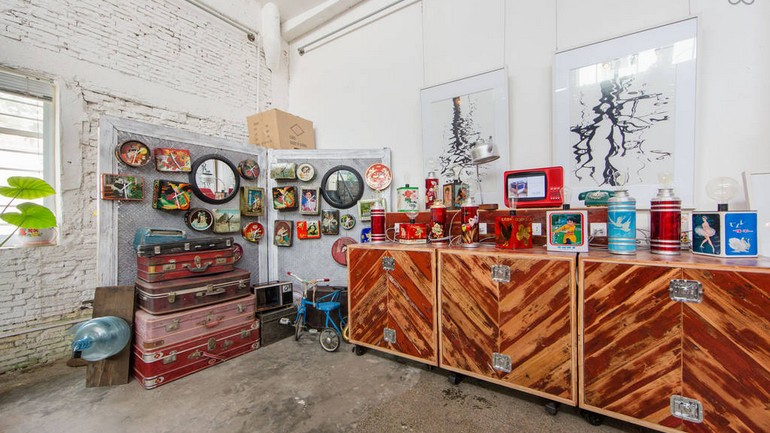
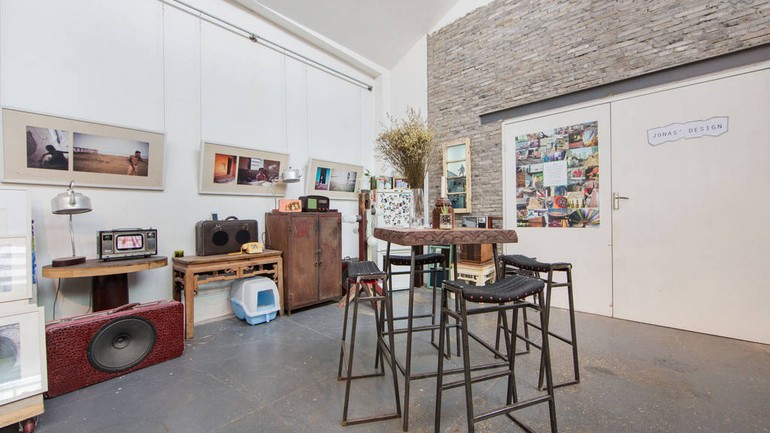
“I started to build the first pieces of furniture for us and it gave me all these ideas about how I could turn old pieces of furniture into something different,” he said. “I slipped into doing this upcycling thing and haven’t stopped since.”
“我开始拼装我们自己用的第一件家具,然后这就启发了我,可以如何把一些旧家具改造成某种不同的东西,”他说,“我渐渐开始做这种升级再造的物品,从那以后就再也没有停下来。”
The influence of this passion is evident throughout the house, from the bathroom sink stand made from an antique Chinese dressing table to the old kettles fitted with light bulbs that hang above the kitchen table, which Mr. Merian also made from recycled wood.
这种热情的影响力在整栋房子里随处可见,从浴室里一个用古旧的中式梳妆台做成的水池台,到那些装了电灯泡并悬挂在厨房餐桌上的旧水壶。梅里安说,那张餐桌也是用回收再利用的木头制作的。
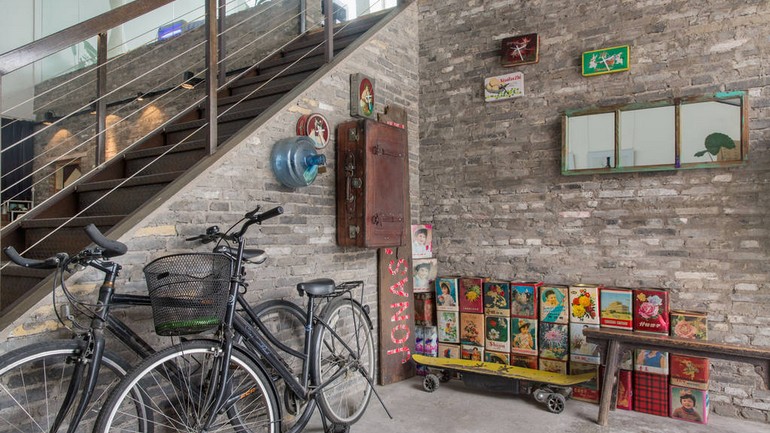
“For living, this is the center,” Ms. Chen said of the table. “This is my favorite place.”
“对于生活而言,这里是中心区,”陈女士说到这张桌子,“这是我最喜欢的地方。”
Mr. Merian agreed: “Our living room is upstairs, but we actually spend most of our time here. This table is the most central and social area in our place.”
梅里安也表示赞同:“虽然楼上就是客厅,但我们大部分时间其实都是在这里度过的。这张桌子就是我们家最核心、最具社交功能的区域。”



 闽公网安备 35020302035673号
闽公网安备 35020302035673号
0 responses on "A different lifestyle in "warehouse home" in Shanghai"